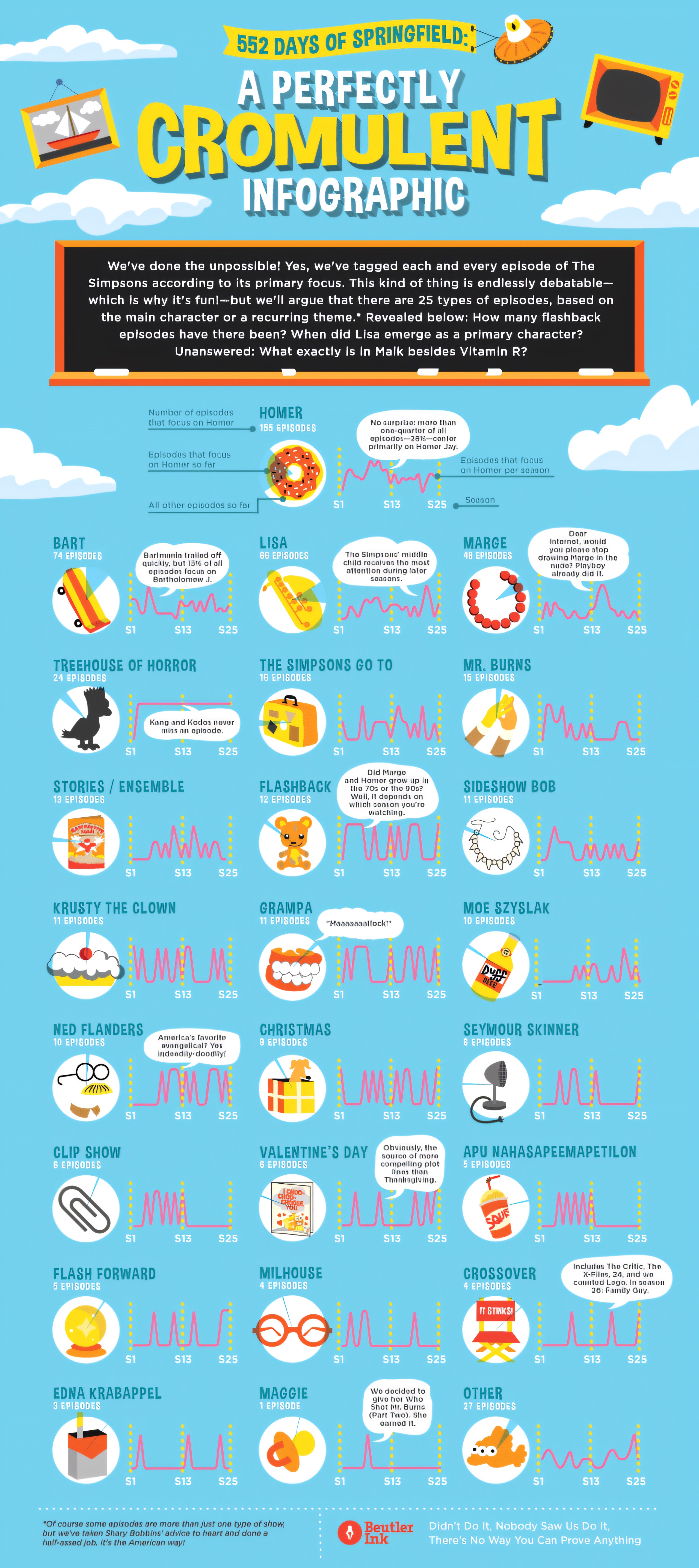Detailed Overview and Analysis: “552 Days of Springfield: A Perfectly Cromulent Infographic”
This engaging and colorful infographic takes an ambitious deep dive into The Simpsons, one of television’s longest-running animated shows, by categorizing every single episode into 25 unique types. Each category reflects either a recurring theme, a central character, or a narrative focus. By charting these episodes visually across seasons, it reveals fascinating patterns about how The Simpsons evolved over its decades-long run.
Dominance of Homer: The Beating Heart of Springfield
Homer Simpson is undoubtedly the focal point of the series, claiming a whopping 165 episodes as primarily “Homer-focused.”
- The graph for Homer’s episodes shows consistent peaks across seasons, especially in earlier years (Seasons 3-10), where his bumbling antics and relatable struggles became the backbone of the show’s humor and charm.
- Notably, Homer-centric episodes account for one-quarter of all episodes—a testament to his role as the show’s comedic and emotional center.
From classic episodes like “Homer’s Phobia” to later explorations of his parenting misadventures, Homer Jay Simpson remains a character whose everyman appeal transcends generations.
Bart and Lisa: From Chaos to Introspection
- Bart Simpson (74 episodes): Bart’s mischievous personality dominated much of the show’s early years, particularly Seasons 1-6, when “Bartmania” swept pop culture. Episodes like “Bart Gets an F” showcase his lovable rascal side, though his prevalence diminishes slightly in later seasons as the show shifts focus to broader narratives.
- Lisa Simpson (68 episodes): Lisa’s thoughtful, moralistic character gained prominence as the show matured. Her episodes reflect deeper, introspective storytelling, exploring themes of identity, intellect, and emotional growth. Episodes like “Lisa the Vegetarian” highlight her progressive ideals, making her a timeless figure for younger audiences.
The contrasting arcs of Bart and Lisa illustrate The Simpsons’ dual ability to appeal to both chaotic humor lovers and those seeking thoughtful character development.
Marge Simpson: A Subtle, Yet Steady Presence
- Marge (48 episodes): Marge-centric episodes offer a window into her struggles as a wife, mother, and individual, balancing her roles within a chaotic family. While her screen time may not rival Homer or Bart, Marge’s episodes, such as “Marge vs. the Monorail,” show her quiet strength and moral compass.
Interestingly, the infographic notes that while Marge’s focus is less frequent, it often provides narrative stability and emotional depth, grounding the show’s more absurd storylines.
Recurring Themes and Specials: A Structural Deep Dive
The infographic smartly breaks down some of The Simpsons’ recurring episode types, many of which became beloved staples:
- Treehouse of Horror (24 episodes): This Halloween-themed anthology remains a fan favorite, known for its satirical takes on horror, sci-fi, and pop culture. Spikes across the timeline reflect its seasonal consistency.
- Flashback Episodes (12 episodes): These episodes often delve into the Simpsons family’s past, exploring Homer and Marge’s romance or showcasing the kids as babies. Such episodes highlight the show’s unique ability to combine humor with touching nostalgia.
- The Simpsons Go To… (16 episodes): Episodes that involve the family traveling (e.g., Japan, New York, or Australia) provide a comedic lens on cultural satire. These “destination” episodes maintain a steady presence, especially in later seasons.
- Stories/Ensemble (13 episodes): These are episodes that focus on interconnected storylines involving multiple characters. Episodes like “22 Short Films About Springfield” epitomize the show’s ability to balance a large ensemble cast.
Fan Favorites: Side Characters Shine Bright
The infographic highlights episodes focusing on Springfield’s quirky, memorable supporting characters. Key categories include:
- Mr. Burns (14 episodes): The villainous yet frail billionaire brings his eccentricities to episodes like “Rosebud.”
- Sideshow Bob (11 episodes): Kelsey Grammer’s portrayal of the Shakespeare-quoting, revenge-obsessed Bob made these episodes fan-favorites. The graphs show periodic spikes coinciding with his calculated returns.
- Moe Szyslak (10 episodes): Homer’s tragic, lonely friend shines in stories that delve into his personal miseries and fleeting victories.
Other notable side characters include Ned Flanders, Milhouse, Grampa Simpson, and even short-lived “clip show” episodes, all offering their unique contributions to Springfield’s lore.
Unique and Niche Categories
Some of the most intriguing insights come from smaller, yet significant categories:
- Valentine’s Day Episodes (6 episodes): Love and heartbreak form the center of these stories, often offering deeper emotional moments.
- Flash Forward Episodes (5 episodes): These episodes explore possible futures for the Simpsons family, with inventive scenarios that project Lisa, Bart, and Maggie’s adult lives.
- Crossover Episodes (4 episodes): Episodes like “Simpsons Guy” (a Family Guy crossover) and “A Star Is Burns” (featuring The Critic) show the series’ cultural footprint extending into other animated universes.
Lastly, the “Other” category (27 episodes) captures episodes that defy traditional categorization, a fitting tribute to The Simpsons’ unending creativity and willingness to experiment.
The Visual Appeal: A Perfectly Cromulent Presentation
This infographic isn’t just informative—it’s visually engaging. The use of colorful graphs and icons makes it easy to identify trends across seasons. Each graph’s peaks and dips tell a story of character focus and thematic exploration, making it possible to observe which characters or story types gained or lost prominence over time.
The whimsical descriptions—like “unpossible!” and nods to the show’s cultural gags—enhance the fun, irreverent tone, perfectly aligning with The Simpsons’ spirit.








